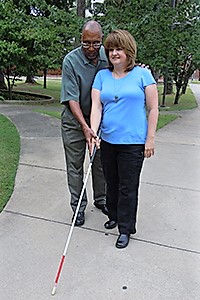Orientation and Mobility: Getting Around
 Learning to use the white
Learning to use the white
cane with an O&M instructor
Orientation and Mobility (O&M) is a profession specific to blindness and low vision that teaches safe, efficient, and effective travel skills to people of all ages:
- “Orientation” refers to knowing where you are and where you want to go, whether you’re moving from one room to another or walking downtown for a shopping trip.
- “Mobility” refers to the ability to move safely, efficiently, and effectively from one place to another, such as walking without tripping or falling, crossing streets, and using public transportation.